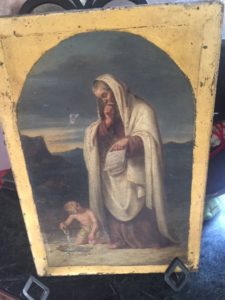 JE sent me photos of a wonderful small 8 x 12 oil on canvas, a portrait of the aged Abraham, the father of the little infant at his feet, Isaak. She told me she purchased this 30 years ago form an older woman who brought it from Germany. The more you gaze at this little painting, the more you need to know your Genesis story from the Bible/Tanach. When you study paintings based on the Bible, one must know the visual language expressed. To know the visual language is to step back into a time before most of Europe was literate.
JE sent me photos of a wonderful small 8 x 12 oil on canvas, a portrait of the aged Abraham, the father of the little infant at his feet, Isaak. She told me she purchased this 30 years ago form an older woman who brought it from Germany. The more you gaze at this little painting, the more you need to know your Genesis story from the Bible/Tanach. When you study paintings based on the Bible, one must know the visual language expressed. To know the visual language is to step back into a time before most of Europe was literate.
The little naked infant, so vulnerable, smiles up at the old man. The old man holds a precious scroll, perhaps a reference to Moses. His name, Yitzhak, translates as “he will laugh.” This refers to the parable of the little boy’s mom, Sarah, who laughed when the angel told her of her pregnancy. At age ninety, and Abraham at 100, Sarah laughed again at Isaak’s birth, and predicted Isaak bringing laughter to others. But first, he endured a great ordeal much later in his young life.
Notice the little boy plays with a shell and pours out grains of sand on the beach. This refers to the learned bond, which the Tanach tells us occurred between the ancient father and his son. Abraham will tell Isaak that God instructed him to count the stars in the heavens. Like the stars in the sky are grains of sand.
The little piece foretells the trial Isaak will have to face in his adolescence. God will commanded Abraham to show his allegiance by sacrificing his son. When the fated event takes place, God sends an angel and a ram to stand in for Isaak. Look at the way the old man holds his chin in his hand. He contemplates both the inevitable future and the treasure of the little boy.
 As well as the ancient myth, I date the little piece by the arch of painted gold, which acts as a self-frame, and the back of the piece. Backs of paintings often tell the BEST story of the date of the painting. Look at the handmade canvas, and the hand hewn wooden stretches which seem made of a soft wood, such as pine. This will prove important in locating its origin, if the stretchers are original to the painting. Pine will indicate a European origin. Also indicative are the old school wooden ‘keys”, those little wooden insets that force the canvas to tighten. They’re old technology, found on paintings previous to the late 19th century.
As well as the ancient myth, I date the little piece by the arch of painted gold, which acts as a self-frame, and the back of the piece. Backs of paintings often tell the BEST story of the date of the painting. Look at the handmade canvas, and the hand hewn wooden stretches which seem made of a soft wood, such as pine. This will prove important in locating its origin, if the stretchers are original to the painting. Pine will indicate a European origin. Also indicative are the old school wooden ‘keys”, those little wooden insets that force the canvas to tighten. They’re old technology, found on paintings previous to the late 19th century.
The piece is unsigned, not surprisingly. I believe it painted by a guild painter for a church or cathedral by one of the building’s artisans. These workers worked for money and the glory of the job, and God, and not for name recognition. The piece, because of the gold framing, may have been painted for the back screens of a church altar, a retablo. From the 15th century forward, these screens came embellished with tales from the Bible because most of the congregants couldn’t read. They learned the Word from the pictures. A standard theme for such altar pieces became images like the trial of Abraham, who is often seen contemplating the future sacrifice of his son. God speaks to Abraham as a proof of faith, and this undying faith serves as a lesson.
Thus, the gold arch acts as a unifying element. The piece slotted into a specific framed area of the back altar. By the look of the canvas the piece dates from the late 18th century. My best guess says this painting isn’t Italian because it doesn’t have the finesse of an Old Master style painting. But it appears Continental, the word we use for central Europe, as Germany was not Germany at this point.
The old piece tells a treasured story, well executed in simple straightforward style, perhaps painted by an artisan trained to interpret Bible stories with his heart more than the expertise of his craft. JE will perhaps never know the name of the painter. My guess of the value is $800-1,000.